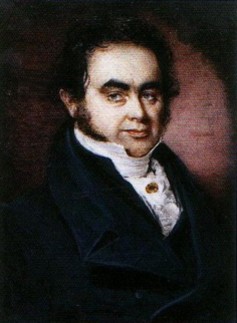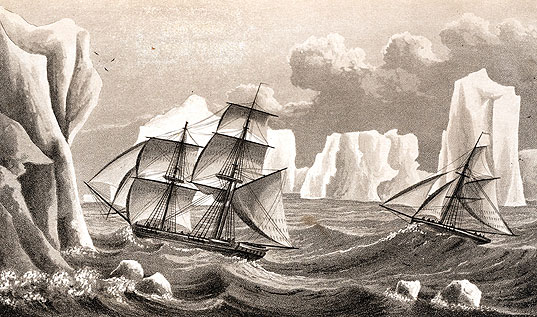<Back to Index>
- Explorer James Weddell, 1787
- Writer Jorge Luis Borges, 1899
- King of the Netherlands William I Frederick, 1772


James Weddell (Ostend, August 24, 1787 – September 9, 1834) was an English sailor, navigator and seal hunter who in the early Spring of 1823 sailed to latitude of 74°15' S (a record 7.69 degrees or 532 statute miles south of the Antarctic Circle) and into a region of the Southern Ocean that would later become known as the Weddell Sea.
He entered the merchant service very early in his life and was apparently bound to the master of a Newcastle collier (a coal transport vessel) for some years. About 1805 he shipped on board a merchantman trading to the West Indies, making several voyages there. James Weddell's father married Sarah Pease.
He was aboard the Hope when in 1813 in the English Channel she captured the True Blooded Yankee, an American privateer. With the end of the Napoleonic War he
was laid off on half pay in February 1816, and for a while resumed
merchant voyages to the West Indies. In 1820 he volunteered for service
in the Royal Navy and subsequently served on several ships. In 1819 Weddell was introduced to James Strachan, a shipbuilder of Leith, who together with James Mitchell, a London insurance broker, owned the 160-ton brig Jane, an American-built ship taken during the war of 1812 and re-fitted for sealing. News of the discovery of the South Shetland Islands had
just broken, and Weddell suggested that fortunes might be made in the
new sealing grounds. His first voyage as the captain of the Jane took him to the Falkland Islands and
further south. He returned with the holds full, and the voyage was so
profitable, that Strachan and Mitchell had a second ship, the Beaufoy, built. The next voyage from 1821 and 1822 took both ships to the South Shetland Islands. However, there were some 45 sealers operating in the area and seal were
already becoming rare (a mere two years after the discovery of the
islands!), and so he scouted for new hunting grounds. Michael McCleod,
the captain of the Beaufoy, sighted the South Orkney Islands on
November 22, 1821, an independent discovery from that of Powell just a
few days earlier. There, they hunted for seals, and arrived back in England in July. On the third voyage from 1822 to 1824, Weddell again commanded the Jane, while the captain of the Beaufoy was
one Matthew Brisbane. Together they sailed to the South Orkneys again.
Sealing proved disappointing, though, and after searching for land
between the South Shetlands and the South Orkneys (and not finding
any), they turned south in the hope to better sealing ground there. The
season was unusually mild and tranquil, and on February 20, 1823 the
two ships had reached latitude 74°15' S and longitude 34°16'45" W:
the southernmost position any ship had ever reached before, a record
that would hold for more than 80 years. A few icebergs were sighted but
there was still no sight of land, leading Weddell to theorize that the
sea continued as far as the South Pole. Another two days' sailing would
have brought him to Coat's Land (to the east of the Weddell Sea) but Weddell decided to turn back. After
deciding to go back, Weddell cheered the crew with the announcement of
being southward of any former navigator and a little ceremony; the
colors were hoisted, a gun was fired, both crews gave three cheers, and
an allowance of grog dispelled the gloom. A hope was infused that
fortune might yet favor the crew of sealers. The area was named The Sea of George the Fourth but the naming did not become permanent. The region would not be visited again until 1911, when Wilhelm Filchner discovered the Filchner-Ronne Ice Shelf. Weddell returned north and sheltered at South Georgia, where he and his crews searched for the elusive seal. They wintered at the Falklands and
sailed again for the South Shetlands in November 1823. At the beginning
of 1824, the two ships separated. Weddell returned in March 1824 to the
Falklands and headed back to England, where he arrived in July. His record for a southerly voyage, three degrees beyond that of James Cook,
caused some raised eyebrows. Weddell was persuaded by Strachan and
Mitchell to incorporate everything in a book. The first edition
appeared in 1825, followed by a second enlarged edition in 1827,
incorporating some information from the Beaufoy which had returned to England in 1826. Weddell
appears to have been resident in Edinburgh, Scotland, in the summer of
1826, when he was cited for non-payment of a debt of £245, loaned
to him by the Commercial Bank. Papers now in the National Archives of
Scotland show that he and his sponsors appear to have fallen out over
liability for payment, and is probably more than coincidence that the
navigational instruments taken by Weddell on board, cost, according to
his book, £240. The Leith merchants engaging him may have felt
that these were unnecessary for a sealing expedition, yet Weddell has
been criticised by such historians as David Walton for failing to take
more instruments, not fewer. The legal papers fail to indicate what
happened to the debt, and Weddell seems to have fled south - failing
even to collect Fellowship of the Royal Society of Edinburgh from Sir
Walter Scott. Weddell offered his services to the Admiralty with
a proposal for a return voyage to the high southern latitudes, but was
turned down. Instead, he returned to trading along the warmer Atlantic
coasts. In 1829 he was still master of the Jane, but on a passage from Buenos Aires to Gibraltar the Jane leaked so badly that she had to be given up at the Azores. Weddell and his cargo were transferred to another ship for the passage to England, but this ran aground on the island of Pico, and Weddell only barely survived. The loss of the Jane meant
financial ruin for Weddell, who was forced to take paid employment as a
ship's master. In September 1830 he left England as master of the Eliza, bound for the Swan River Colony in western Australia. From there he proceeded to Tasmania. He sailed back to England in 1832. Weddell died in 1834 at the age of forty-seven in relative poverty and obscurity in London. Two places are named after him - the Weddell Sea, and Weddell Islands in the Falklands. The Weddell Seal was also named for him.